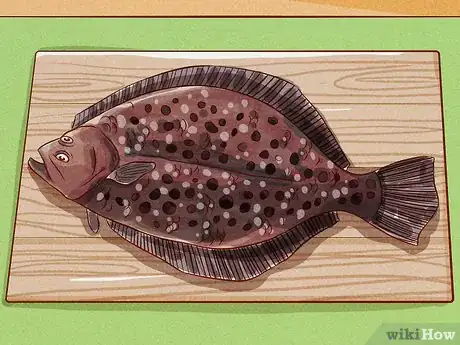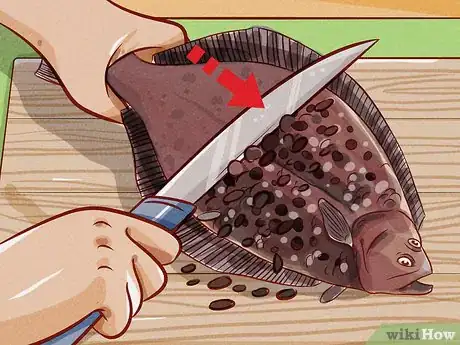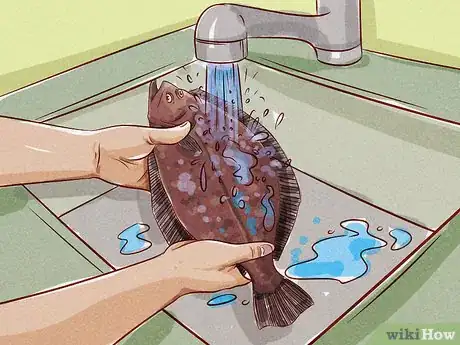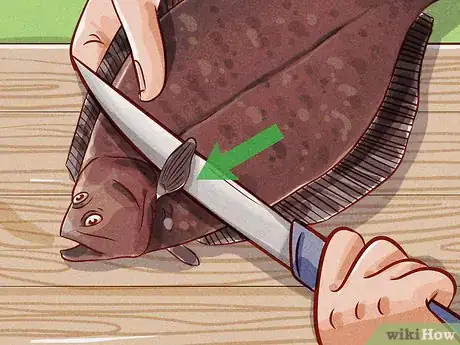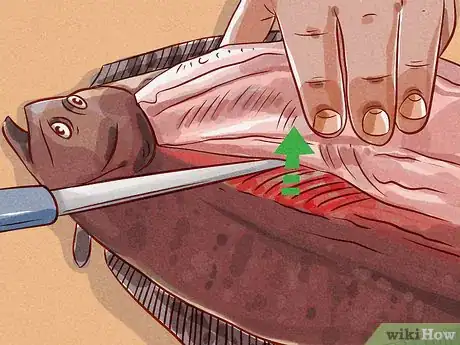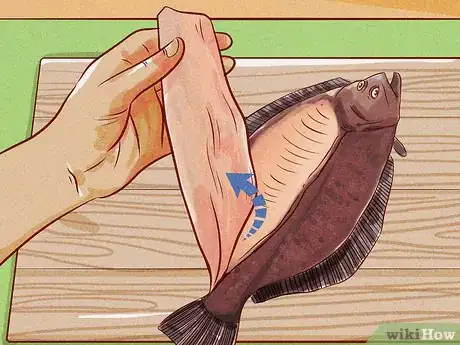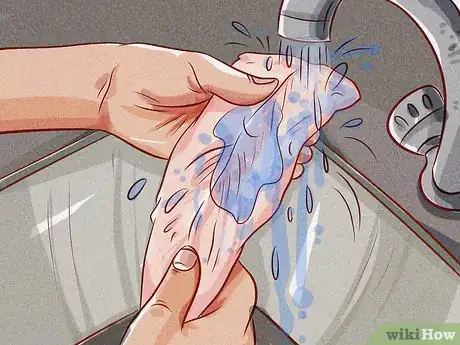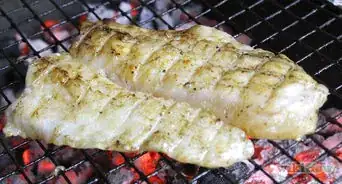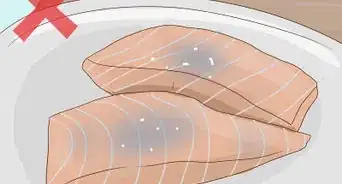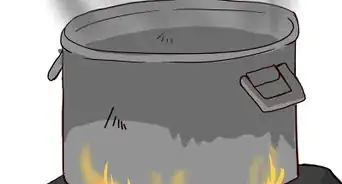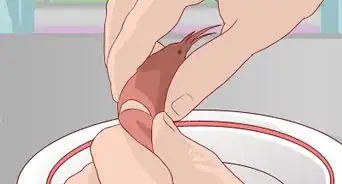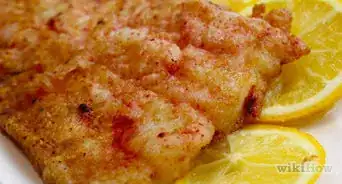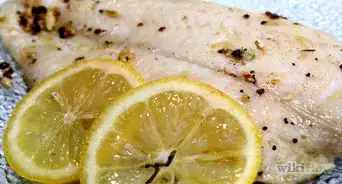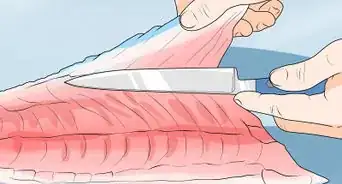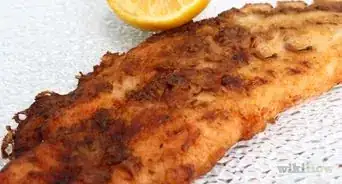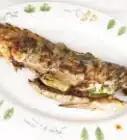This article was co-authored by wikiHow Staff. Our trained team of editors and researchers validate articles for accuracy and comprehensiveness. wikiHow's Content Management Team carefully monitors the work from our editorial staff to ensure that each article is backed by trusted research and meets our high quality standards.
This article has been viewed 96,065 times.
Learn more...
Flounder are flatfish, usually caught in coastal lagoons and estuaries of the Pacific Ocean and the Northern Atlantic Ocean. They make up many popular dishes, due to their low levels of fat and calories, and high protein content. In order to properly cook the flounder, you have to clean it first by scaling it, which removes the slime coating and outer scales. Then, you can quickly and easily fillet the fish.
Steps
Scaling the Flounder
-
1Lay the flounder on a flat surface and hold it firmly by the tail. Most healthy flounder are covered in a fine layer of clear slime which keeps them safe in the water. To remove this, you have to scale the flounder. Place the flounder on a clean, flat surface such as a cutting board. Place your non-dominant hand on the tail to hold it in place.[1]
- Removing the scales can be business. If you’re worried about messing up the kitchen, place a layer of newspaper or a plastic bag over the cutting board for easier clean up.
Warning: If the flounder’s slime coating is a milky white color, discard the fish immediately. This means that the meat has spoiled.
-
2Scrape the back of a knife from the tail to the head. Hold a knife with the blunt side flat on the flounder’s skin. Then, drag the knife along the skin until you reach the head of the fish. Repeat this motion, working from the tail to the head, until all of the slime and most of the scales have been removed.[2]
- Remember to rinse off your knife as needed to remove excess slime and scales from the back of the blade.
- If you have a fish scraper, you can use that instead of the back of a knife.
Advertisement -
3Flip the fish over and scrape the other side. Once you’ve removed the scales and slime from one side, pick up the flounder and turn it over to expose the other side. Hold the tail again with your non-dominant hand, and scrape from the tail to the head with the back of the knife.[3]
- Don’t worry about setting the fish on top of some of the scales that have flaked off. You’ll be rinsing the flounder after you scale it.
-
4Rinse the flounder under cool running water to remove excess scales. Carefully transfer the fish to a sink and turn on the cool water. Be sure to clean both sides of the fish, and use your hands to rub the skin and remove any scales that may be stuck to the surface.[4]
- The skin should feel clean, not slimy or slick. If it does feel slimy, try scaling both sides again to see if any additional slime collects on the knife.
Cutting Fillets
-
1Cut a vertical line behind the head from the top of the fish to the bottom. With a small, sharp knife, slice the fish through the skin just behind the head and past the side fin. The knife should reach the bones of the fish, but not cut through them. Do this on both sides of the fish, and then choose which side to start filleting.[5]
- This vertical line will likely be somewhere near the gills, depending on the anatomy of the fish.
-
2Score horizontally across the spine to the tail. Find the flounder backbone, which runs down the middle of the fish from the gills to the tail. Cut along this line, from the center of the gills to the tail. Follow the backbone while cutting.[6]
- Remember that you should cut through the skin to the bone, but don’t press the knife through the bone.
-
3Slice from the center of the spine to the fins, along the ribs. Insert the tip of the knife under the skin, along the backbone. Slice from the gill along the ribs to the tail. Continue cutting until the fillet is separated from the backbone, and leave the flesh attached on the outer edges of the carcass.[7]
- You should be working from the center vertical line outward to the fin around the edge of the flounder’s body.
-
4Peel the fillet upward as you cut through the meat. While moving the knife, continue lifting the side of the fish that you’re cutting. Hold the meat of the fillet as you separate it from the bone, and peel it backward so that it’s only attached along the outer edges of the carcass.[8]
- As you peel the fillet away from the carcass, you should be able to see the ribs and spine of the fish. If not, try cutting your fillet a little thicker next time.
-
5Remove the fillet from the fins and turn the fish over to repeat the process. Cut along the outer edge of the carcass to remove the fillet. Then, turn the fish over and make the same incisions under the flesh and next to the backbone. Cut the fillets in the same manner on this side until you’ve made as many fillets as possible, which is usually 2-4.[9]
Tip: If you want to remove the skin before cooking the fish, simply place the fillet with the skin facing up, and carefully insert the knife under the skin. Cut across the fillet until the skin is separated from the meat.
-
6Rinse and chill the fillets immediately until you’re ready to cook them. Run the fillets under a steady stream of cool, running water to clean them off before storing. Then, place the meat in an airtight container and store it in the refrigerator until you’re ready to cook the meat. If you’re planning to cook the fish at a later date, it’s best to freeze it and thaw it before cooking.[10]
- There are quite a few ways to prepare flounder, such as baking, grilling, or sauteing!
Community Q&A
-
QuestionWhat is the best way to minimize the mess made?
 MicheleTop AnswererCleaning fish is a messy project. Keep a pail or plastic bag open to discard the fins, skin and entrails to minimize mess.
MicheleTop AnswererCleaning fish is a messy project. Keep a pail or plastic bag open to discard the fins, skin and entrails to minimize mess. -
QuestionHow do I cook pan-fried whole flounder?
 Community AnswerSee the wikiHow article, How to Cook Flounder.
Community AnswerSee the wikiHow article, How to Cook Flounder. -
QuestionCan flounder be grilled?
 Community AnswerYes, flounder tastes great grilled over hickory chips with seasoned salt and lemon. You can use cooking spray on the grates and quarter turn them to prevent the fish from sticking. Beware of inedible "arrowtooth flounder" that Wal-Mart sells - this fish turns to a tastless mush no matter what you do with it.
Community AnswerYes, flounder tastes great grilled over hickory chips with seasoned salt and lemon. You can use cooking spray on the grates and quarter turn them to prevent the fish from sticking. Beware of inedible "arrowtooth flounder" that Wal-Mart sells - this fish turns to a tastless mush no matter what you do with it.
Things You'll Need
- Sharp knife
- Cutting board
- Flounder
References
- ↑ https://www.greatbritishchefs.com/how-to-cook/how-to-scale-a-fish
- ↑ https://www.greatbritishchefs.com/how-to-cook/how-to-scale-a-fish
- ↑ https://www.greatbritishchefs.com/how-to-cook/how-to-scale-a-fish
- ↑ https://www.greatbritishchefs.com/how-to-cook/how-to-scale-a-fish
- ↑ https://www.saltstrong.com/articles/how-to-fillet-a-flounder/
- ↑ https://www.saltstrong.com/articles/how-to-fillet-a-flounder/
- ↑ http://www.daybreakfishing.com/flounderfillet.html
- ↑ http://www.daybreakfishing.com/flounderfillet.html
- ↑ http://www.daybreakfishing.com/flounderfillet.html
About This Article
To clean flounder, start by laying the flounder on a flat surface and scraping the back of a knife from the tail to the head to remove the slime and scales. Then, repeat on the other side of the fish, and rinse it off under cool water to remove any leftover scales. Next, cut a vertical line from the top of the fish to the bottom, right behind the head. Once you've done that, cut horizontally along the spine to the tail, and cut the fillet away from the spine and ribs. Finally, flip the flounder over and repeat on the other side. To learn how to store flounder fillets before cooking them, scroll down!
